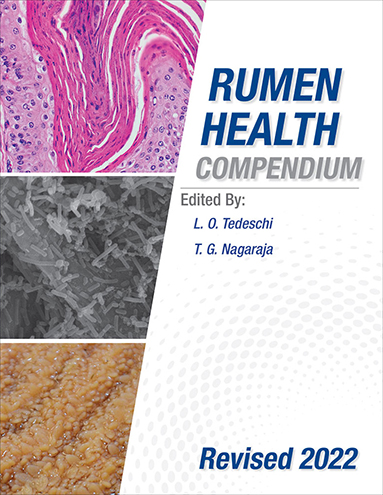
Availability: In Stock/Ready to Ship.
Suggested retail price shown above.
For discounted Bookstore or School District bulk orders: Contact Us
Recently revised in 2022, The Rumen Health Compendium book was designed to be the first option for knowledge seekers to get acquainted with preliminary information filled with illustrations and applied recommendations related to ruminant production sciences. The book also contains a vast number of references for those in quest of more in-depth knowledge about the topics.
The purpose of this book publication is to help clarify the main metabolic diseases related to beef and dairy cattle rumen health, making diagnosis easier, and perhaps more important to support best practices and prevention. The format of this publication takes into account the importance of this information for veterinarians, nutritionists and managers involved in the daily operations of feeding animals, so that they benefit most from the contents.
Ruminants are formidable biomachines that are capable of transforming human-inedible organic material, i.e., fibrous plant parts, into human-edible, high-quality animal products (e.g., meat and milk) as a result of a remarkable symbiotic relationship with microbes that co-exist in the reticulorumen. A complex microbiota composed of anaerobic bacteria, fungi, and protozoa resides in the reticulorumen. The rumen microbiota are responsible for the fermentation of complex, polymerized organic material that yields readily available, absorbable products (e.g., acetate, propionate, butyrate), microbial mass, and less polymerized nutrients (e.g., peptides and oligosaccharides), which can be enzymatically digested and absorbed post-ruminally, and further metabolized by the ruminant animal. This cooperative arrangement between ruminants and their reticulorumen microbes is the result of more than 40 million years of evolution and adaptation to diverse ecozones in the four corners of the world. Humans have benefited from ruminants in many ways. Ruminants provide not only high-quality food to humans, ameliorating global hunger, but also draft for crop production and irrigation, transportation, renewable energy, wealth, clothing, and serves for pharmaceutical and biomedical purposes. Ruminants hold enormous importance for the progression of humankind. Therefore, learning how to nurture and care for them is essential not only for their welfare but also to develop sustainable ruminant production under complex grassland-ecosystems.
This book examines contemporary issues related to the rearing of ruminants, especially beef and dairy cattle, focused on maintaining a healthy, functional rumen mainly through nutritional interventions. We invited renowned authorities in the fields of nutrition, microbiology, behavior, veterinary, zoology, and physiology to cover diverse aspects of rumen health and dysfunction. In Part 1, we covered the fundaments of the rumen, including anatomy, physiology, rumen development and adaptation, ruminal microbiome, and ruminal contents. In Part 2, we delved into the strategic manipulation of the rumen through feeding modifiers, pathology of the rumen wall/epithelium, sub-acute acidosis, liver abscess due to feeding, bloat, and the poisoning of ruminants due to feeding. Part 3 emphasized ways to diagnose problems in the reticulorumen through its content s physicochemical characteristics and the visual appraisal of feces. Finally, Part 4 highlighted common gut foodborne pathogens and a contemporary issue about antimicrobial resistance.
Dear Reader,
We would like to give special thanks to the scientists involved in this project. Their contributions, knowledge and experience in this field supported the development of this book, and should be used as a valuable reference for years to come. Our special thanks to Dr. Tedeschi and Dr. Nagaraja, for their commitment and contributions, as well as the many hours spent selecting, reviewing and refining the contents of this compendium.
Phibro believes that Virginiamycin is a meaningful tool in the prevention of SARA (sub-acute ruminal acidosis), a silent metabolic disorder. We are committed to continued investment in additional research to help control relevant rumen health disorders.
Phibro has a responsibility to deliver safe, effective, sustainable products and to provide expert guidance regarding their use. Our products help to prevent and control diseases and optimize nutrition to support animal health and productivity. We have a responsibility to engage with our customers, stakeholders and consumers, who want information about the food they eat and how it is produced.
Our mission is to provide safe and effective solutions for our customers' unique challenges. Our purpose is to optimize animal health and nutrition for better lives and a more sustainable world.
Phibro Animal Health Corporation is a diversified global developer, manufacturer and supplier of a broad range of animal health, nutritional specialty and direct-fed microbial (or probiotics) products for livestock, that help veterinarians, nutritionists and farmers produce healthy and affordable food.
For further information, please visit www.pahc.com
Phibro Animal Health Corporation
Teaneck, NJ
January 2020